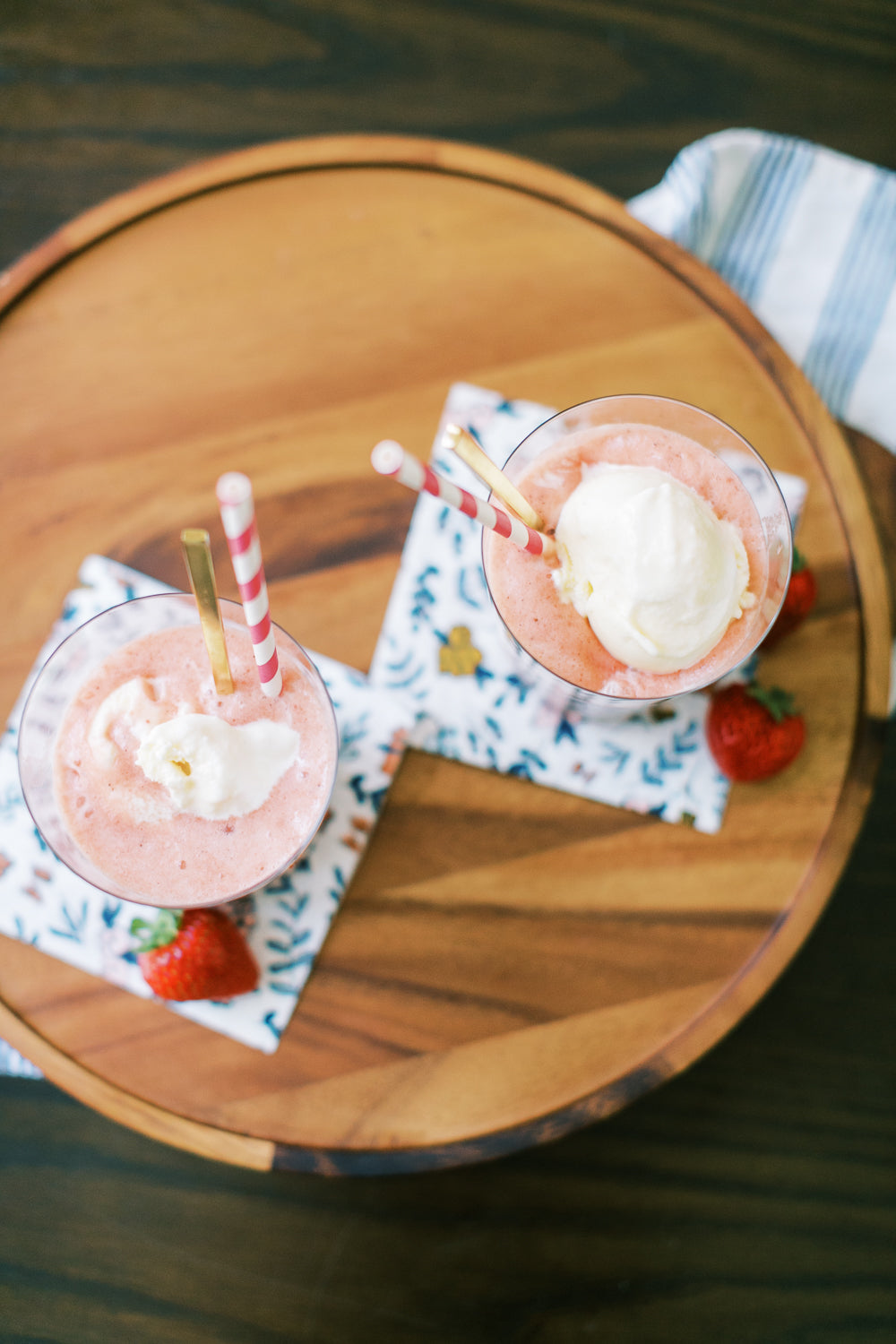Where on earth did Summer go, you guys? While the past few months have sometimes seemed to crawl by, I can hardly believe that summer is coming to an end, kids are starting school, and Fall is just around the corner. Don’t get me wrong, I’m ready for cooler weather, cozy sweaters and all the pumpkin spice lattes, but I think one last end-of-summer “cheers!” is in order.
This roasted strawberry & vanilla ice cream float is summer in a glass. Sweet and tangy strawberries, caramelized in the oven, and mixed with the rich taste of vanilla ice cream is what summer dreams are made of. You can even get fancy and throw in a different flavor ice cream (chocolate ice cream would be delish!). It’s the perfect way to welcome the kids home after school or the perfect post-dinner dessert during the last toasty Summer days. Snag the recipe below and let us know how you celebrate Summer’s end with your family!

ROASTED STRAWBERRY ICE CREAM SODA FLOAT
INGREDIENTS:
- 1lb fresh strawberries
- 4 tbsp honey, divided
- 1 teaspoon lemon juice
- 1/4 tsp vanilla extract
- 2-3 cups sparkling water (I chose Topo Chico)
- 1 pint vanilla ice cream
DIRECTIONS:
- Preheat oven to 425º and line a baking sheet with parchment paper.
- Halve the strawberries and place them in a bowl with 2 tbsp of honey, lemon juice, and vanilla extract. Toss strawberries to coat. Place strawberry halves face down on baking sheet and put in the oven. Roast for 20-25 minutes, rotating pan halfway through until berries are tender and juices are beginning to caramelize.
- Transfer berries into a food processor or blender. Add remaining 2 tablespoons honey and blend into a puree. Transfer to a bowl, cover with plastic wrap and put in the refrigerator to cool completely.
- To make the soda, use a ratio of 1 part strawberry puree to 2 parts sparkling water (for example, 1 cup puree to 2 cups sparkling water). Stir to combine. Reserve any extra puree to place at the bottom of each glass.
- To assemble your floats, drop a few spoonfuls of puree at the bottom of each glass, add your ice cream (I did about 2 big scoops per glass), pour strawberry soda on top, and serve with spoons and straws!



334 comments
cialis canada generic cialis india how much does cialis cost
https://canlipornolar.com/
курсы таро
Tegs: ясновидящая https://videnie.org/
вернуть любимого
таролог москва
снять порчу
Scientists have found a new method of fighting antibiotic-resistant bacteria
cialis generic cialis side effects with alcohol cialis logo
Stress often causes bacteria to form biofilms. Stress can manifest as a physical barrier, ultraviolet light, or a toxic substance such as antibiotics. The formation of these biofilms takes from several hours to days, and they can be of different shapes, sizes, colors, and textures depending on the type of bacteria. Being in a biofilm state protects them from harmful substances in the environment – biofilms have a unique outer wall with different physical and chemical properties than their individual cells. They can coordinate metabolism, slow down their growth, and even form an impenetrable barrier of wrinkles and creases. This is one of the ways they achieve high antibiotic resistance. Researchers from the United Kingdom recently studied the transition of the Hay Bacillus bacterium from a free-moving swarm to a biofilm as a defense mechanism and published what they did to combat its antibiotic-resistant properties in eLife.
To determine if their test strain was behaving like the others, they first ran stress tests on them. They tested the bacteria’s response to the physical barrier, ultraviolet light, and antibiotics. The addition of a physical barrier led to the transition of bacteria from one layer to a multilayer layer, followed by an increase in cell density and the formation of multilayer islands near the barrier. Later, wrinkles formed on the islands near the barrier in the place where they began to appear initially.
does cialis make you last longer cheap cialis viagra vs cialis price
When they applied ultraviolet light to the swarm, they again observed a drop in cell speed and an increase in density. And after the scientists added a large dose of the antibiotic kanamycin, the bacterial cells formed a biofilm. The researchers then developed a strategy to combat this bacterial biofilm. They added kanamycin to the environment of a new batch of swarming bacterial cells and watched as the biofilm began to form. They then re-injected the antibiotic at a much higher dose than the first, just before the biofilm formation was complete. As a result, the partially formed biofilm was destroyed and bacterial cells died. This shows that antibiotic-resistant bacteria lose their resistance to antibiotics when they undergo a phase transition, right before going into the biofilm, where they will become much more resistant. Thus, with the correct administration of antibiotics, the bacteria can be attacked in their most vulnerable state and destroyed. The researchers believe that similar transitions from swarm to biofilm occur in other bacterial species. Their research may pave the way for finding more effective ways to control clinically relevant bacteria. For example, Salmonella enterica, which spreads into the bloodstream and is transmitted through contaminated food. Or Pseudomonas aeruginosa with multiple drug resistance, which after surgery causes infections in the blood, lungs (pneumonia) and other parts of the body and spreads in hospitals.
what is cialis used for cialis 20mg cialis manufacturer coupon 2018
Canli Pornolar